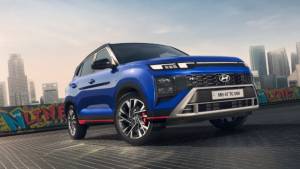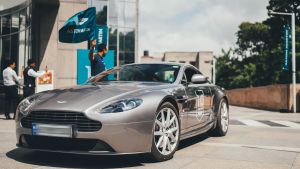Turning a new Leaf
Team OD
Updated: May 09, 2013, 04:12 PM IST
A few weeks ago, I took the Nissan Leaf out on the Grand Prix circuit at Silverstone. Electric cars have many attributes â" and some downside as well - but, with the exception of the Porsche-priced Tesla two-seater, race track performance is not one of them.
Drive the electric Leaf in town and it is as quiet and gentle as any of the new generation of battery-powered cars. Put it on a track and a different character emerges: flat-out acceleration brings it to an indicated maximum speed of 158kmph; set it up for a fast bend and it steers accurately and stays composed; power it out of a slow corner and, with the traction control turned off, it will spin its wheels ferociously. It's not a sports car but it is lively and more fun to drive than you would ever have expected.
The Silverstone test was part of day for the British members of the Car of the Year jury to assess the seven finalists for the 2011 title, prior to the final voting. On November 29 in Paris their votes were counted along with the other 51 jurors from 23 European countries. The Nissan Leaf emerged the winner, nine points ahead of the Alfa Giulietta and 13 clear of the third-placed Opel Meriva.
The Leaf is the first Car of the Year that does not have a combustion engine. Nissan chief executive Carlos Ghosn said that winning the award endorsed his claim that the Leaf is 'the start of a new zero-emissions era for the automobile'.
The Nissan was not the only plug-in contender for Car of the Year. The Mitsubishi iMiEV, also sold as the Citroen Z-Zero and Peugeot iOn, did not make the final seven. It was judged to be a less complete car than the Leaf, which is purpose-built rather than an adaptation of an existing model, and has better accommodation and performance for the same (high) price.
I will come back to the cost of buying and running one of these new electric cars. First, let's examine what makes the Leaf. It is a five-door hatchback, a touch bigger than a Volkswagen Golf and with similar interior space. The styling is fairy conventional, though the LED headlamp units stand proud of the bonnet to divert air round the door mirrors in the interests of a low drag coefficient: 0.29.
The Leaf does not stand out from the crowd; that was intentional for Nissan wanted it to be accepted as a normal car rather than a symbol of environmentalism.
That even extends to the engine, or rather the motor, bay where at first glance the cover over the motor and power electronics looks like the cam box of a combustion engine. The electric motor drives the front wheels and produces a maximum of 80kW (110PS), about the same as a regular four-cylinder engine in this class but with 280Nm, the torque of a bigger V6. It needs no variable-speed gearbox, so drive is engaged by selecting 'D', as with an automatic transmission.
The Leaf's platform is unique and houses the 24kWh battery pack â" comprising 192 laminated lithium-ion cells â" under the floor and within the wheelbase. Placing this 250kg battery pack low down at the centre of the car benefits ride and handling.

There is nothing unusual about the suspension layout, with MacPherson struts at the front and a torsion beam at the rear. The steering has electric power assistance â" arguably, a little too much - but the brakes are conventional hydraulic. When braking or coasting there is energy regeneration back through the motor which acts as a generator but, unlike some other electric cars, this response is not too fierce. In fact, it feels natural, like conventional engine braking.
A characteristic of all electric cars is the eager step-off from rest â" 0-50kmph acceleration. This smooth, instant response makes the Leaf seem quicker than it actually is. The official figures are 0-100kmph in 11.9 seconds and a top speed of 145kmph â" though in hot laps at Silverstone the speedometer climbed well beyond that.
The Car of the Year jurors were surprised not only by how well the Leaf performed on the track but also by the supple way it absorbed the bumps of typical English country lanes while maintaining handling poise. In other words, how well developed it is as a car, independent of its power source.
Nonetheless, opinions and votes for the Leaf varied widely. Twenty of the 58 jury members put the Nissan in first place. Strong support came from the UK and Germany but the Southern Europeans were much less enthusiastic; the six Spanish jurors gave the Leaf only two points between them.
The reasons are clear: price and range. Some European countries are giving subsidies and other incentives to encourage people to become early adopters of electric cars. New technology is bound to be expensive but the purchase price of the Leaf - £29,000 in the UK â" is far too high for most of its intended customers and the whole-life costs simply don't add up.
The Car of the Year jury, like the motoring general public, is used to all-purpose cars. If you own a Leaf you have to have a second car â" unless you never make trips of more than 160km. Nissan accepts it is not for everyone. The target buyer will use it for short journeys at moderate speed and have easy access to electric power points at home and destination.
To keep two cars running all day at our Silverstone test, we had to bring in a portable rapid charger â" an expensive piece of kit that uses 63 amp, 400 volt supply and can bring the car's batteries up to 80 per cent full charge in 30 minutes. Normal recharging overnight using the household mains takes eight hours.
Nissan has equipped the Leaf with some sophisticated systems to alleviate 'range anxiety' â" the buzz-word of the electric car movement. Energy-efficient driving is encouraged by various facia displays, of which the most gimmicky is a tree symbol that grows and blossoms if you are easy on the throttle. A finger touch on the flat-screen centre panel provides an instant 'distance to empty' as well as a map showing the 'reachable area' and the standard navigation system uses the internet to direct you to the nearest charging station when the available range falls below 20km.
The snag, of course, is that there are hardly any charging stations. But with most car manufacturers now planning to offer pure electric cars, the infrastructure is expected to grow steadily over the next 2-3 years.
Nissan has been bold to spearhead the electric car revolution and the Leaf is a well-engineered leader. Its innovation, competence and green credentials are what sold it to the Car of the Year jury. Whether it will be a commercial success remains to be seen. In many ways, range extended hybrids look a better bet but Carlos Ghosn says they defeat the object of the pure electric car which is zero emissions. But then there is the argument about how the electricity is generated. It's not easy being a pioneerâ¦
Price (Ex-Delhi)
-NA-
-NA-
Displacement
-NA-
-NA-
Transmission
Automatic
Automatic
Max Power(ps)
149.5
149.5
Max Torque(Nm)
320
320
Mileage
-NA-
-NA-
Related Stories
Top Stories
Latest Videos
Most Popular
1
2
1
2
Network18 Updates
Compare














